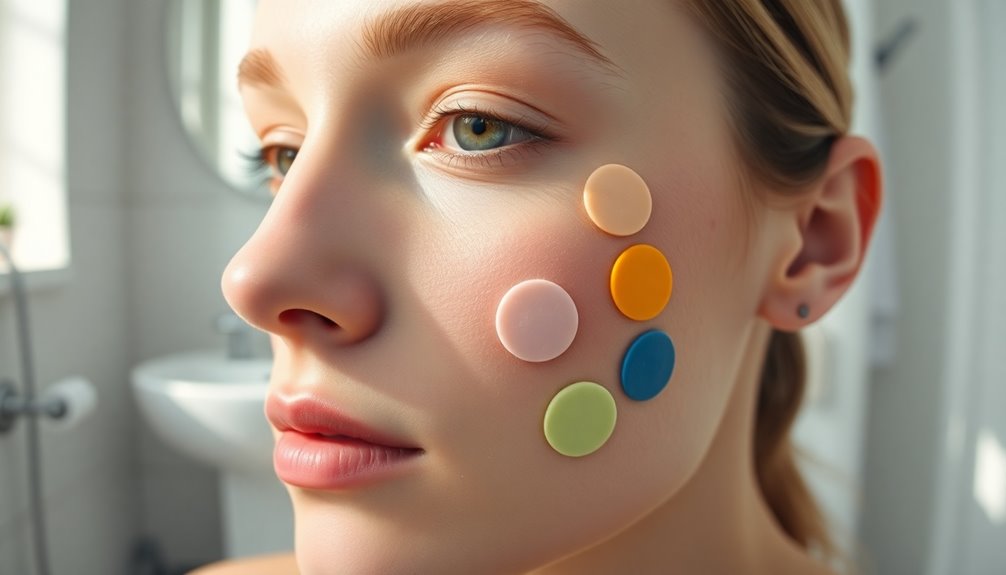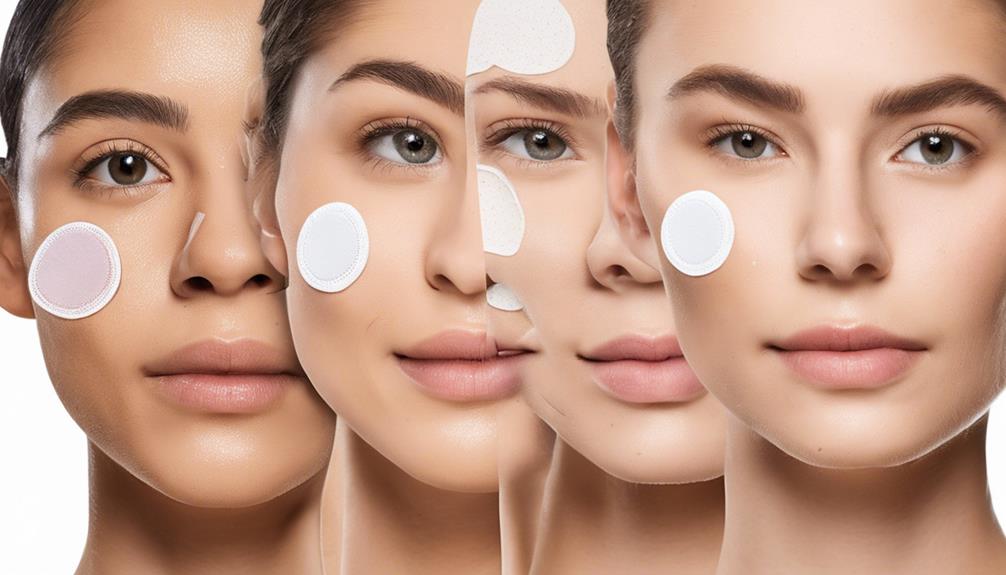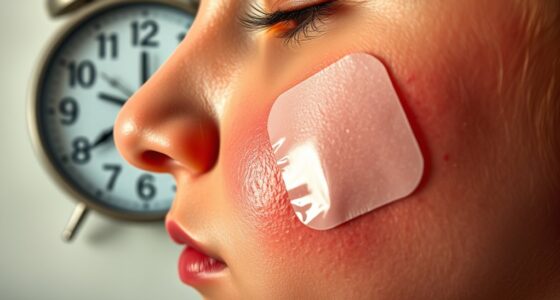DIY pimple patches can provide some benefits, like being cost-effective and offering a barrier against irritants. However, they often lack the precise ingredients and efficacy of commercial options. While they may help, especially with minor breakouts, stubborn cystic acne often requires more robust treatments. If you're looking for better results or alternative solutions, you'll discover more options that might suit your skin needs better.
Key Takeaways
- DIY pimple patches can be cheaper alternatives but often lack the effectiveness of commercial options due to inferior ingredients.
- While they can absorb moisture and provide a protective barrier, DIY patches may not effectively treat stubborn cystic acne.
- Using hydrocolloid bandages with added active ingredients can enhance the efficacy of homemade patches, but results may vary.
- Professional acne treatments generally outperform DIY patches, offering more targeted and effective solutions for severe cases.
- Individual skin responses to DIY patches differ, so consulting with a dermatologist for tailored approaches is recommended for optimal outcomes.
Understanding the Basics of Pimple Patches

When you're dealing with a pesky pimple, pimple patches can be a game changer. These adhesive hydrocolloid patches are specifically designed to treat acne by absorbing excess moisture and creating a protective barrier over the pimple.
They work best on open wounds, as they draw out pus and fluid while keeping the area clean. By forming a gel upon contact with moisture, pimple patches help flatten pimples and accelerate the healing process. Additionally, hydrocolloid technology promotes healing by drawing out impurities, making these patches even more effective.
Available in various sizes and often translucent or skin-toned, these patches offer discreet daytime use. While they can be effective for occasional breakouts, remember they don't prevent future acne or tackle underlying issues, so consider them part of a broader skin care routine.
Pros and Cons of DIY Pimple Patches

Although DIY pimple patches can be an appealing and cost-effective solution for treating acne, they come with both benefits and drawbacks that are important to evaluate.
Here's a quick look at the pros and cons:
- Cost-effective: DIY patches are generally cheaper than commercial options.
- Hydrocolloid properties: They can mimic the moisture-retaining qualities of hydrocolloid patches, aiding in healing.
- Protects your skin: They can provide a barrier against external irritants.
- Lack of active ingredients: DIY patches often miss the precise formulation of commercial acne treatments, potentially reducing effectiveness.
- Limited efficacy: Unlike clinically formulated patches, DIY options may not effectively target stubborn cystic acne.
While they may help prevent acne temporarily, DIY patches mightn't deliver results comparable to clinically formulated pimple patches designed for effective acne treatment.
Common Materials Used in DIY Pimple Patches

Creating effective DIY pimple patches starts with selecting the right materials. Hydrocolloid bandages are an excellent choice, as they absorb moisture and promote healing through their gel-forming properties.
You might also consider using adhesive medical tape combined with a small piece of cotton or gauze to create a makeshift patch that protects the pimple while absorbing pus.
For added benefits, you can apply natural ingredients like tea tree oil or aloe vera to enhance antimicrobial effects. Tea Tree oil has been noted for its antibacterial properties and can be particularly beneficial in treating acne.
Some methods suggest mixing a thin layer of hydrogel or gelatin with active ingredients like salicylic acid to mimic commercial patches.
Just remember, it's essential that any materials you use are sterile to avoid irritation or infection.
Effectiveness of Homemade vs. Commercial Pimple Patches

When you compare homemade and commercial pimple patches, the difference in ingredients is striking.
Commercial patches often use hydrocolloid material and active ingredients that enhance healing, while DIY versions might fall short in both efficacy and protection.
You'll want to take into account how these factors impact your acne treatment outcomes. Additionally, the effectiveness of various ingredients can significantly influence the healing process of blemishes.
Ingredients Comparison
The debate between homemade and commercial pimple patches often hinges on their ingredients and effectiveness.
Here are some key differences:
- Hydrocolloid Gel: Commercial patches use this material to create a moist environment that draws out fluids effectively.
- Active Ingredients: Commercial options often include salicylic acid or niacinamide, targeting acne severity more efficiently.
- Antibacterial Properties: While DIY ingredients like tea tree oil may offer some antibacterial benefits, they don't match the effectiveness of commercial patches.
- Soothing Benefits: Homemade patches can provide soothing effects, but they lack the moisture-retaining capabilities essential for ideal healing.
Ultimately, commercial patches combine targeted action and convenience, making them generally more effective than DIY solutions for managing breakouts. Additionally, maintaining good indoor air quality can help reduce skin irritations that may worsen acne.
Healing Efficiency
While you might consider DIY pimple patches as a quick fix, their healing efficiency often falls short compared to commercial options. Commercial pimple patches utilize hydrocolloid, which creates a moist environment that's vital for reducing acne size and inflammation. In contrast, homemade patches typically lack this essential material and may not absorb drainage effectively.
| Aspect | DIY Pimple Patches | Commercial Pimple Patches |
|---|---|---|
| Hydrocolloid | No | Yes |
| Active Ingredients | Rarely | Often (e.g., salicylic acid, tea tree oil) |
| Healing Efficiency | Low | High |
Dermatologists consistently recommend commercial products due to their tested effectiveness in targeting bacteria and promoting faster healing. Furthermore, understanding the importance of early detection in various health issues can help in making informed choices about skincare products.
Tips for Creating Your Own Pimple Patches

Creating your own pimple patches can be a simple and effective way to tackle breakouts at home. Follow these tips to make your DIY pimple patches:
- Start with hydrocolloid bandages: These materials absorb moisture and create a healing environment for your pimples.
- Cut to size: Trim the bandages into small pieces, ensuring they're slightly larger than the pimple for effective coverage.
- Add powerful ingredients: Before applying, add a drop of tea tree oil or salicylic acid to the center of the patch for enhanced benefits.
- Clean the skin: Always apply the patch on a clean surface to improve adhesion and effectiveness.
Leave your patches on for several hours or overnight to absorb moisture and reduce inflammation effectively. Additionally, maintaining skin hydration is crucial, as it supports the healing process and helps reduce the appearance of blemishes.
Alternatives to DIY Pimple Patches

If DIY pimple patches aren't cutting it for you, there are plenty of alternatives to evaluate.
Over-the-counter treatments like salicylic acid can be more effective, while professional options like chemical peels offer targeted solutions for stubborn acne.
You might also explore natural home remedies that can complement your skincare routine without the hassle of DIY patches. Additionally, consider budgeting for skincare treatments to ensure you can afford effective products and services that cater to your specific needs.
Over-the-Counter Treatments
When you're looking for effective alternatives to DIY pimple patches, over-the-counter treatments offer a range of options that can tackle acne more efficiently.
Here are four popular choices:
- Salicylic Acid: This active ingredient reduces inflammation and unclogs pores, making it ideal for acne-prone skin.
- Benzoyl Peroxide: An antiseptic that kills acne-causing bacteria, though it can irritate sensitive skin.
- Adapalene: A topical retinoid that promotes skin cell turnover, preventing and healing acne effectively.
- Foaming Cleansers: Look for those with tea tree oil or glycolic acid to remove dirt and excess oils that lead to breakouts.
Additionally, incorporating nourishing ingredients into your skincare routine can enhance overall skin health and improve acne treatment outcomes.
These over-the-counter treatments can be more effective than DIY pimple patches, especially for persistent issues.
Professional Dermatological Options
While DIY pimple patches can be convenient, professional dermatological options provide more effective solutions for managing acne. Consulting a dermatologist allows you to access prescription topical treatments containing higher concentrations of active ingredients, like salicylic acid and retinoids, which outperform DIY alternatives.
For persistent or severe acne, professional treatments such as chemical peels or laser therapy can target deeper skin layers, ensuring long-lasting results that pimple patches simply can't achieve. These treatments exfoliate the skin and clear clogged pores more effectively than over-the-counter options. Additionally, understanding the environmental factors that contribute to skin issues can guide tailored treatment plans for improved outcomes.
Natural Home Remedies
Natural home remedies offer a range of alternatives to DIY pimple patches, often utilizing ingredients you may already have at home. You can tap into these effective solutions to reduce inflammation and promote the natural healing process:
- Honey and Cinnamon: This mix combats bacteria and reduces inflammation.
- Diluted Tea Tree Oil: Apply cautiously to kill acne-causing bacteria and reduce redness.
- Aloe Vera Gel: Known for its soothing properties, it helps reduce redness and heals acne-affected areas.
- Cool Green Tea: This provides antioxidants and anti-inflammatory benefits, calming irritated skin.
Additionally, a paste made from crushed aspirin can treat active pimples by unclogging pores.
These natural remedies can be just as effective as traditional acne patches.
Frequently Asked Questions
Do Pimple Patches Work on Unpopped Pimples?
Pimple patches work quite well on unpopped pimples, especially those that are raised and filled with pus.
When you apply them, they create a moist environment that aids in healing. The hydrocolloid material absorbs excess fluid, helping to flatten and reduce inflammation.
For the best results, you should apply the patches as soon as a pimple appears and leave them on for several hours or overnight to maximize their effectiveness.
Are Pimple Patches Actually Effective?
Did you know that hydrocolloid patches can reduce pimple size by up to 50% in just one night?
When you use pimple patches, you're applying a targeted approach to healing. These patches absorb excess moisture and create a moist environment that promotes faster healing.
They work best on open, draining pimples, but won't prevent future breakouts.
If you want a quick solution for occasional acne, pimple patches can be a great option.
Can I Make My Own Pimple Patch?
Yes, you can definitely make your own pimple patch!
Start by using hydrocolloid bandages, cutting them to fit your blemish.
Make sure your skin is clean and dry for better adhesion.
While DIY patches can help absorb moisture and promote healing, remember they won't have the targeted ingredients found in commercial options.
The results may vary based on your skin type and the materials you choose, so keep that in mind!
Is It Better to Use a Pimple Patch or Leave It Alone?
When deciding whether to use a pimple patch or leave it alone, it's often better to opt for the patch.
It absorbs excess fluid, reduces redness, and protects the area from bacteria. By using a patch, you're promoting faster healing and preventing the urge to pick at it.
Leaving it alone might expose the pimple to irritants, prolong inflammation, and increase the risk of scarring.
Conclusion
In the grand scheme of skin care, DIY pimple patches can be a fun little experiment, but they might not pack the punch you're hoping for. While they offer an engaging way to tackle pesky blemishes, commercial options often come with proven ingredients and reliability. So, if you're feeling crafty, go ahead and whip up your own, but don't be surprised if you find the store-bought variety to be the shining star in your pimple-fighting arsenal.










